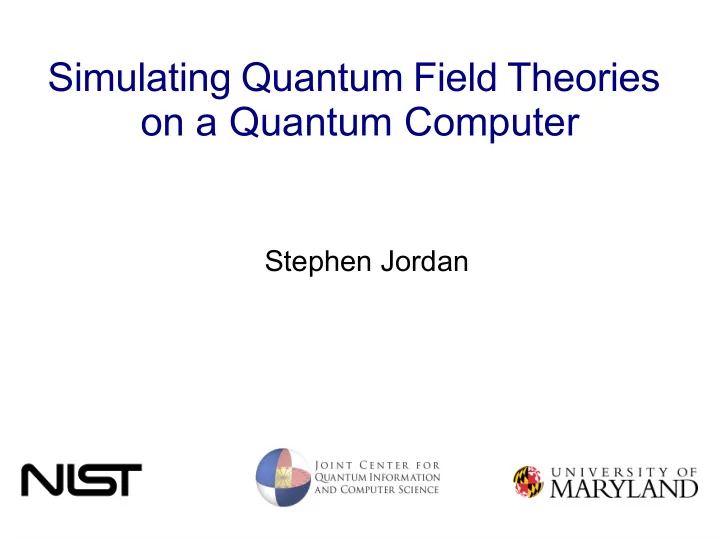

Simulating Quantum Field Theories on a Quantum Computer Stephen Jordan
C a n q u a n t u m c o m p u t e r s s i m u l a t e a l l p h y s i c a l processes efficiently? Universality Conjecture: Quantum circuits can simulate all physical dynamics in time. Status: Non-relativistic QM Yes: Now being optimized Quantum Field Theories Probably: In progress Quantum Gravity/Strings Nobody knows
Quantum Field Theory ● Much is known about using quantum computers to simulate quantum systems. ● Why might quantum field theory be different? – F i e l d h a s i n f i n i t e l y m a n y d e g r e e s o f f r e e d o m – Relativistic – Particle number not conserved – Formalism looks different.
When do we need QFT? Nuclear Physics Accelerator Experiments Coarse-grained many-body systems Cosmic Rays
Classical Algorithms There's room for exponential speedup by quantum computing.
A QFT Computational Problem Input : a list of momenta of incoming particles. Output : a list of momenta of outgoing particles.
Results So Far ● Efficient quantum simulation algorithms: Bosonic Fermionic Jordan, Lee, Preskill Jordan, Lee, Preskill Massive ArXiv:1404.7115 (2014) Science , 336:1130 (2012) ? ? Massless ● BQP-hardness: classical computers cannot perform certain QFT simulations efficiently [S. Jordan, H. Krovi, K. Lee, K. Preskill, 2017] ● Better Speed and Broken Symmetries [A. Moosavian and S. Jordan, 2017]
Representing Quantum Fields A field is a list of values, one for each location in space. A quantum field is a superposition over classical fields. A superposition over bit strings is a state of a quantum computer.
Our Algorithms 1) Choose a lattice discretization. Bound discretization error (by renormalization group). 2) Prepare physically realistic initial state. Is the most time-consuming step. This depends strongly on which QFT simulated. 3) Implement time-evolution by a quantum circuit. Use Trotter formulae. 4) Perform measurements on final state. Complicated by vacuum entanglement.
Lattice Cutoff Continuum QFT = limit of a sequence of theories on successively finer lattices.
Mass: Interaction strength: Coarse grain Mass: Interaction strength:
Lattice Cutoff Continuum QFT = limit of a sequence of theories on successively finer lattices.
Adiabatic State Preparation Prepare wavepackets in free theory, then adiabatically turn on interaction. Problem:
Adiabatic State Preparation Solution: intersperse backward time evolutions with time-independent Hamiltonians. This winds back dynamical phase on each eigenstate without undoing adiabatic change of basis.
Simulating Detectors ● Measure energy in localized regions: ● Need smooth envelope function to avoid excessive vacuum noise!
Runtimes
Improved State Prep: Bosons ● In some cases (e.g. weakly coupled d=2), preparing the free vacuum is the rate limiting step. ● We can do this much faster using Bogoliubov transformation that looks like a Fast Fourier Transform. [Somma, Jordan, unpublished] ● Essentially same idea as 2 n d quantized FFT from: [Babbush, Wiebe, McClean, McLain, Neven, Chan, 2017]
Improved State Prep: Fermions ● Two problems with adiabatic state preparation: – Cannot reach symmetry-broken phase – Runtime bound not practical: ● A solution for both: – First, prepare the vacuum from MPS – Then, resonantly excite single-particle wavepackets – Tighter analysis: CFT entropy and Floquet theory: [A. Moosavian, S. Jordan, 2017]
Tensor Network Ansatzes image credit: G. Evenbly
Tensor Network Ansatzes image credit: G. Evenbly [Swingle, Kim, 2017]
Near-Term Prospects? quantum science commercial supremacy applications applications ● Simulating conformal field theories using MERA-based variational eigensolvers ● Simulating commuting Hamiltonians ● Simulating high-connectivity systems, e.g. spin glasses or SYK model
Near-Term Prospects? quantum science commercial supremacy applications applications ● Simulating conformal field theories using MERA-based variational eigensolvers ● Simulating commuting Hamiltonians ● Simulating high-connectivity systems, e.g. spin glasses or SYK model Thanks!
Recommend
More recommend